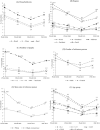National Trends and Disparities in Severe Food Insecurity in Brazil between 2004 and 2018
- PMID: 35425877
- PMCID: PMC9004637
- DOI: 10.1093/cdn/nzac034
National Trends and Disparities in Severe Food Insecurity in Brazil between 2004 and 2018
Abstract
Background: The Brazilian Household Food Insecurity Measurement Scale (EBIA) is the main tool for assessing household food insecurity (FI) in Brazil and facilitates the monitoring and improvement of national public policies to promote food security. Since 2004, the Brazilian government has conducted National Household Sample Surveys, and in 2018, the government carried out the last national evaluation of FI.
Objectives: To describe trends in severe FI in Brazil from 2004 to 2018.
Methods: Data from 3 cross-sectional Brazilian National Household Sample Surveys (sample sizes: 2004 = 112,530; 2009 = 120,910; 2013 = 116,196) and from the last Household Budget Survey (sample size = 57,920) that assessed the status of FI using the EBIA were analyzed. Changes in severe FI during 2 periods (2004-2013; 2013-2018) were estimated while considering sociodemographic factors.
Results: The period between 2004 and 2013 was marked by a significant decrease in severe FI (-53.6%), but this trend reversed in 2013-2018 (+43.8%). The greatest decrease in severe FI occurred in the Northeast (-57.6%) among households where the reference person was a man (-57.6%) and self-identified as white (-58.1%) (2004-2013). In 2013-2018, households with children aged ≤4 y (+6.3%) and members aged ≥65 y (+12.5%) experienced the lowest increases in severe FI.
Conclusions: After a significant reduction from 2004 to 2013, severe FI increased sharply from 2013 to 2018, likely due to disruptions in public policies aimed at reducing hunger and unemployment rates.
Keywords: Brazil; food and nutrition security; health surveys; hunger; time series studies.
© The Author(s) 2022. Published by Oxford University Press on behalf of the American Society for Nutrition.
Figures


References
-
- Food and Agriculture Organization of the United Nations, International Fund for Agricultural Development, United Nations Children's Fund, World Food Program, World Health Organization . The State of Food Security and Nutrition in the World. 2021. Transforming food systems for food security, improved nutrition and affordable healthy diets for all. Rome: Food and Agriculture Organization of the United Nations; 2021. p.240. Available from: 10.4060/cb4474en. - DOI
-
- Food and Agriculture Organization of the United Nations . Glossary on Right to Food. Rome: FAO; 2009, 138.
-
- Frongillo EA. Validation of measures of food insecurity and hunger. J Nutr. 1999;129(2):506S–9S. - PubMed
-
- United States Economic Research Service . “Food Security in the U.S.: Overview.” United States Department of Agriculture. 2019. [Internet]. [Accessed 2022 Mar 13]. Available from: https://www.ers.usda.gov/topics/food-nutrition-assistance/food-security-....
LinkOut - more resources
Full Text Sources

